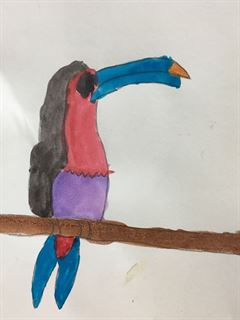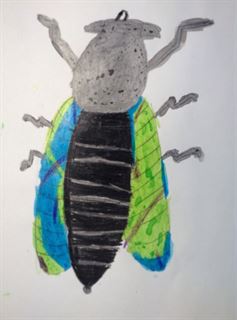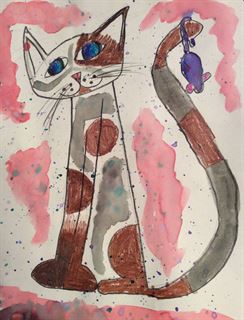Insects, Birds, & Mammals
For since the creation of the world God’s invisible qualities—his eternal power and divine nature—have been clearly seen, being understood from what has been made, so that men are without excuse.
Romans 1:20
Everything that we see around us in nature points to God's majesty and awesome creative ability; God alone is able to create something out of nothing. "By faith we understand that the universe was formed at God's command, so that what is seen was not made out of what is visible" (Hebrews 11:3). Things did not "just happen" on their own without His direction. This becomes evident as we observe insects, birds and mammels He created. We notice that each is created with specific characteristics and unique features.
Enduring Idea:
Relationships-Nature
Essential Questions:
Romans 1:20
Everything that we see around us in nature points to God's majesty and awesome creative ability; God alone is able to create something out of nothing. "By faith we understand that the universe was formed at God's command, so that what is seen was not made out of what is visible" (Hebrews 11:3). Things did not "just happen" on their own without His direction. This becomes evident as we observe insects, birds and mammels He created. We notice that each is created with specific characteristics and unique features.
Enduring Idea:
Relationships-Nature
Essential Questions:
- What is observation?
- What can I learn from observing nature? Observing insects, birds, & mammals?
- How can I use observation to improve my artwork?
Insects
Objectives
Materials:
Computer, pencil, paper, sketchbook, watercolor, brushes, water, paper towels, notecards
Artists:
Process:
- You will identify a specific insect, research and observe its distinct features.
- You will compose a sketchbook and watercolor painting of your insect.
Materials:
Computer, pencil, paper, sketchbook, watercolor, brushes, water, paper towels, notecards
Artists:
Process:
- Observation is very important for the artist. What did you learn about observation from these artists? How might their work be different if they did not spend time observing insects?
- Spend time looking through the Insects.org website for insect pictures.
- What insects are familiar to you? Select one and look for photos that are clear, close-up, have contrast, and are compositionally pleasing. You may print them out to use as a reference.
- Spend time making sketches of your insect. Select your favorite to use for painting.
- Carefully sketch out your insect on watercolor paper. Paint using watercolor.
- Write a description of your insect on a note card to be displayed with your picture. Include insect's name, where it lives, how your painting represents the insect. On the back answer these questions: Did your artwork turn out successful? Why or why not? What would you change if you could?
Birds
Objectives
Computer, pencil, paper, sketchbook, watercolor, brushes, water, paper towels, notecardsArtists:Process:
- You will identify a specific bird, research and observe its distinct features.
- You will compose a sketchbook and watercolor painting of your bird
Computer, pencil, paper, sketchbook, watercolor, brushes, water, paper towels, notecardsArtists:Process:
- Observation is very important for the artist. Check out the artists above and watch the video Szabolcs Kokay.
- What did you learn about observation from these artists? How might their work be different if they did not spend time observing birds?
- Spend time looking through the website 10,000 Birds.
- What birds are familiar to you? Select one and look for photos that are clear, close-up, have contrast, and are compositionally pleasing. You may print them out to use as a reference.
- Watch these videos on how to draw & paint birds.
- You can also check out this website on drawing birds.
- Spend time making sketches of your bird. Select your favorite to use for painting.
- Carefully sketch out your bird on watercolor paper. Paint using watercolor.
- Write a description of your bird on a note card to be displayed with your picture. Include Bird's name, where it lives, how your painting represents the bird. On the back answer these questions: Did your artwork turn out successful? Why or why not? What would you change if you could?
VA.Cr1.1
VA.Cr2.2
VA:Re7.1
Mammals
Objectives
Materials:
Computer, pencil, paper, sketchbook, watercolor, brushes, water, paper towels, notecardsProcess:
- You will identify a specific mammal, research and observe its distinct features.
- You will compose a sketchbook and watercolor painting of your mammal.
Materials:
Computer, pencil, paper, sketchbook, watercolor, brushes, water, paper towels, notecardsProcess:
- Observation is very important for the artist. Check out the artists above. What did you learn about observation from these artists? How might their work be different if they did not spend time observing animals?
- Spend time looking through the websites on mammals.
- What mammals are familiar to you? Select one and look for photos that are clear, close-up, have contrast, and are compositionally pleasing. You may print them out to use as a reference.
- Spend time making sketches of your mammal. Select your favorite to use for painting.
- Carefully sketch out your mammal on watercolor paper. Paint using watercolor.
- Write a description of your mammal on a note card to be displayed with your picture. Include the mammal's name, where it lives, how your painting represents the mammal. On the back answer these questions: Did your artwork turn out successful? Why or why not? What would you change if you could?
VA.Cr1.1
VA.Cr2.2
VA:Re7.1



